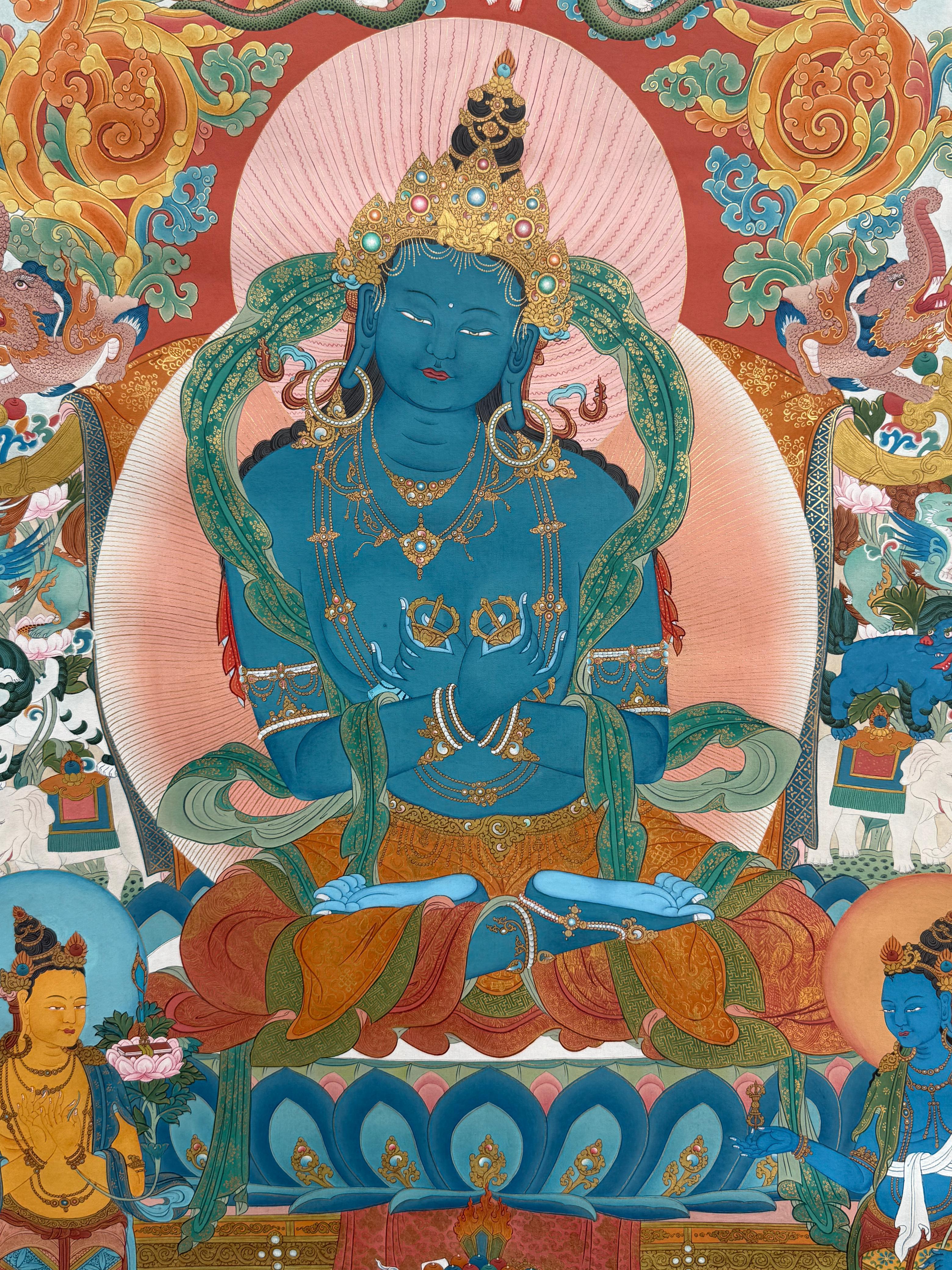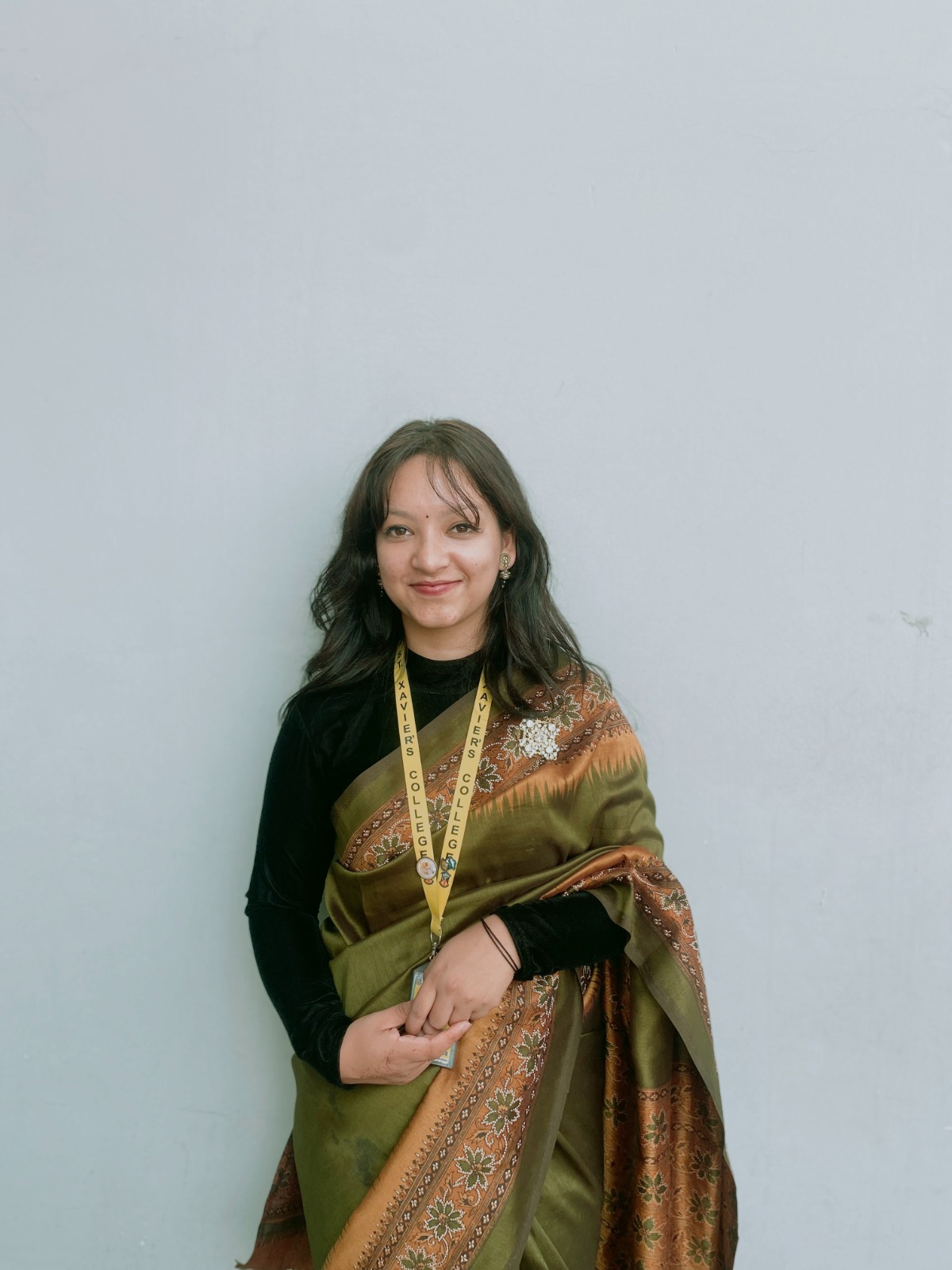Arts
Narrating history through devotional art
Jigme Tamang Mugum’s artworks at Gallery 108 show the lineage of Karmapas and their forebears as a visual cosmology.
Aarya Chand
Stepping into Gallery 108 for ‘Karmapa Gyüpa’, one is immediately struck by a palpable reverence. Unlike conventional exhibitions where bright white walls feature artworks, the space is enveloped in darkness, pierced only by the luminous presence of Thangka paintings. The subdued atmosphere, supported by resonant background chants, makes the room feel more like a sanctum than a gallery. For a moment, the visitor is transported into a monastery, yet what unfolds before the eyes is not ritual alone but an orchestrated visual journey through one of the most influential lineages in Himalayan Buddhism—the Karma Kagyu.
This exhibit, curated around the unbroken line of the Karmapas and their forebears, is the result of nearly five years of sustained devotion by the artist, Jigme Tamang Mugum. Originally from Mugu in Nepal’s Karnali region, Mugum’s initiation into painting followed the traditional gurukul model. Under Lama Urgen’s mentorship from 1987 to 1993, he absorbed the intricacies of Karma Gadri painting, renowned for its elegance, spacious landscapes, and delicate mineral pigments. Rooted in the legacy of the 8th Karmapa, Mikyö Dorje (1507–1554), this style is a distinctly Tibetan tradition. Jigme’s works embody this lineage, yet they are also sharpened by his personal experience of having apprenticed directly in monasteries and gumbas, where sacred art is not merely aesthetic but a devotional practice.
The exhibition opens with six thangkas depicting the ‘forefathers’ of the Kagyu tradition. The sequence begins with Vajradhara, the primordial Buddha, painted in deep cobalt blue, embodying the indivisible union of wisdom and compassion. Vajradhara’s presence as the source of tantric transmission situates the entire exhibit within a cosmological framework.
To his right and left, attendant deities like Manjushree and Vajrapani anchor his role in the broader Buddhist pantheon. Jigme’s brushwork here reveals the Karma Gadri aesthetic at its most refined: the subject stands luminous at the centre while the landscape recedes into an airy stillness, directing focus without overwhelming detail.
Tilopa, Naropa, Marpa, Milarepa, and Gampopa follow, each represented in their narrative context. Tilopa, the wandering yogi who received instructions from a wisdom dakini, is framed alongside symbolic figures such as Chakrasamvara and Vajravarahi. Naropa’s thangka reflects his transition from Nalanda’s scholastic corridors to esoteric practice under Tilopa’s guidance.

Marpa is then presented as the translator-adept whose journeys to India transmitted Vajrayana back to Tibet, while Milarepa, with his gaunt frame, evokes the penance and solitude of a life dedicated to retreat and song. Gampopa, the physician-monk who systematised the Kagyu teachings, is portrayed with Shakyamuni and his disciples—visually signposting the moment the Kagyu tradition crystallised into institutional continuity.
This pedagogical sequence lays the ground for the appearance of the first Karmapa, Düsum Khyenpa (1110–1193), whose realisation and visionary siddhis led to the institution of the Black Crown ceremony. From here, the exhibition unfolds across centuries, presenting each of the Karmapas in chronological order.
Unlike secular portraits, these thangkas are not mere likenesses. They serve as didactic tools, visual commentaries on each Karmapa’s spiritual contribution and historical context. Karma Pakshi (1206–1283), the second Karmapa, is shown amidst Mongol courtiers, signifying his role as teacher to Kublai Khan and the introduction of communal recitation practices i.e. Chenresig's mantra (Om Mani Padme Hum).
Rangjung Dorje, the third Karmapa, who declared himself Karmapa from infancy, is paired with his disciple, the first Shamarpa, thereby marking the dual-lineage structure that characterises Kagyu leadership.
As one moves through the gallery, patterns of iconography become discernible. Each Karmapa is depicted seated, often flanked by disciples, protectors, or patrons. Yet the background remains airy and spacious, in keeping with the Karma Gadri insistence on focus. Jigme deliberately ensures that no subject is cast in shadow—the viewer’s gaze is gently but firmly led to the teacher figure, whose presence is rendered timeless.
Each thangka carries recurring symbols of lineage. Above every Karmapa rests the black crown with sun and moon motifs, signifying timeless wisdom and compassion. A few are also shown with moustaches, a distinctive marker of their Indian origins.
The historical depth of the lineage is vividly apparent. Rölpe Dorje (1340–1383), who was said to recite Chenresig’s mantra at birth, is painted amidst yogis and disciples, signalling his prodigious spiritual authority. Deshin Shegpa (1384–1415), renowned for travelling across Tibet, Mongolia, and China, appears alongside the Ming emperor Yongle, encapsulating a moment of intercultural diplomacy where Buddhist art operated as both devotion and politics. Later Karmapas, such as Mikyö Dorje (1507–1554), the very progenitor of the Karma Gadri style, are shown with disciples and scholars, highlighting their scholastic and artistic innovations.
By the time we arrive at the 17th Karmapas—represented as two co-existing figures in contemporary times—the exhibit makes visible the enduring vitality of this lineage. The Karmapas are not fossilised relics of the past but living teachers whose guidance adapts to the present moment.
In his own words, Jigme asserts that thangka painting should never overwhelm: “when looked at one glance or altogether it should not give pressure to the viewer… one should feel calm when viewing it.” This principle manifests throughout the exhibition. Even as the canvases teem with symbolic detail—bells, vajras, ritual implements, celestial deities—none of it produces visual chaos. The mineral pigments, ranging from muted reds to soft blues and greens, operate harmoniously. The use of red, common in Himalayan painting, is balanced rather than overbearing, offering warmth without aggression.
The installation enhances this affective register. The darkness of the gallery, punctuated by spot-lit thangkas, isolates each work as a radiant portal. The visitor is encouraged to move slowly, almost meditatively, from one lineage holder to the next. A meditation corner placed within the exhibition reinforces this rhythm, inviting not only observation but contemplation.
The experience extends beyond sight. The chanting background score infiltrates the senses, anchoring the visual into an embodied calm. One feels immersed not just in paintings but in the very ethos they articulate: the union of method and wisdom, the continuity of teaching, the aspiration towards enlightenment.
A closer look at the compositions reveals narrative density. In Milarepa’s thangka, for instance, a blackbuck chased by a dog illustrates a parable: the hunter-dog, upon encountering the yogi in deep meditation, abandons violence and takes refuge instead. This layering of storytelling within iconography offers a visual pedagogy—teaching not merely through written scripture but through painted narrative.
Animals appear alongside the followers across other thangkas as well, testifying to the historical role of husbandry and transportation in Himalayan life. Yet their symbolic dimension is equally significant—they embody transformation, refuge, and interdependence within the spiritual journey.
The recurrent presence of vajra and bell in the hands of the lineage holders reinforces doctrinal continuity. Crossed at the heart, they signify the union of compassion and wisdom, method and emptiness. The exhibition even choreographs their placement in alignment as one moves through the hall, creating a subtle rhythm across the gallery that binds the thangkas together.
What makes ‘Karmapa Gyüpa’ particularly striking is its negotiation between ritual tradition and contemporary exhibition practice. Thangkas are traditionally objects of devotion, often housed in monasteries, unrolled for specific rituals rather than displayed for aesthetic appreciation. Here, however, they are curated within a modern gallery context, framed in Himalayan brocade, and supplemented by didactic texts and audiovisual presentations.
This shift reframes the paintings: no longer bound exclusively to ritual function, they become accessible to broader audiences while retaining devotional integrity. The inclusion of reference texts such as ‘The Illustrated Lives of the Five Kagyu Forefathers and the Seventeen Karmapas’ enables viewers unfamiliar with Buddhist lineages to engage with the works meaningfully.
What stands out is Jigme’s insistence that the ultimate purpose of these works is not aesthetic display but spiritual instruction. He remarks, ‘‘if humanity truly absorbed the teachings of the Karmapas, there would be no need to hang the paintings at all.’’ In this sense, the exhibition becomes paradoxical: these thangkas exist both as visual testaments to lineage and as reminders that their highest function transcends material form.
This humility resonates across the collection. Despite his evident technical mastery—seen in the precision of line, the harmony of palette, and the compositional balance—Jigme positions himself as a conduit rather than creator. The works belong not to him but to the lineage, to the teachers whose transmissions he seeks to honour.
Walking out of the darkened gallery, the afterimage of the thangkas lingers. One carries not only colours and forms but also a sense of having touched a lineage that extends across centuries, bridging India, Tibet, Nepal, and beyond. The exhibit succeeds in what it sets out to do: to connect the viewer to the living spirit of Buddhist art, to offer calm rather than pressure, and to remind us that the ultimate teaching lies not on the canvas but in how one carries it into life.
Karmapa Gyüpa
Where: Gallery 108, Durbar Marg, Kathmandu
When: Till October 19
Time: 11:00 am to 7:00 pm
Entry: Free




 11.12°C Kathmandu
11.12°C Kathmandu

%20(1).jpg&w=200&height=120)






%20(1).jpg&w=300&height=200)

